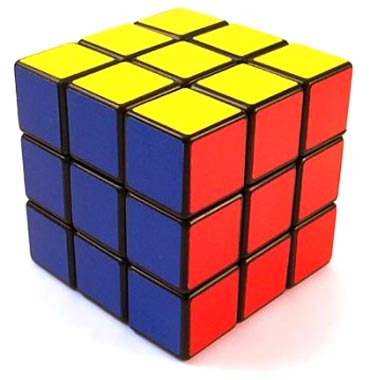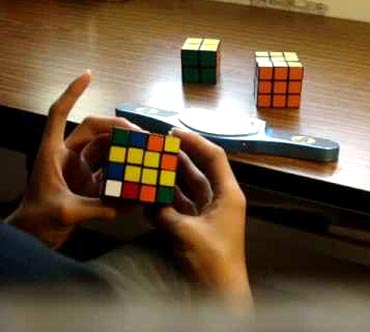 | « Back to article | Print this article |
CAT: How to solve cube and matchstick problems in LR
'If it was so, it might be; and if it were so, it would be; but as it isn't, it ain't. That's logic.' – Tweedledee in Lewis Caroll's Through the Looking Glass.
If the above line confused you, trust me -- you are not alone.
Even God can vanish in a puff of logic. To know how, you can probably jump to the end of this post. To those who choose not to skip -- let us discuss a few common types of Logical Reasoning problems.
Type 1: Cube problems
A cube is given with an edge of unit 'N'. It is painted on all faces. It is cut into smaller cubes of edge of unit 'n'. How many cubes will have 'x' faces painted?
In these types of questions, the first thing that we need to figure out is the number of smaller cubes.
For this, we look at one particular edge of the big cube and figure out how many smaller cubes can fit into this. It will be N/n. So, the number of smaller cubes will be (N/n)3
A cube has 6 faces and none of the smaller cubes will have all faces painted. As a matter of fact, none of the smaller cubes will have even 5 or 4 faces painted. The maximum number of faces, which will be painted on a smaller cube, will be 3. This will happen only in the case of the smaller cubes that emerge from the corners of the big cube.
So, number of smaller cubes with 3 faces painted = 8 (Always)
For 2 faces to be painted, we will have to consider the smaller cubes that emerge from the edges of the big cube (leaving out the corners). So, the smaller cubes on every edge will be (N-2n)/n. There are 12 edges in a cube.
So, number of smaller cubes with 2 faces painted = 12 (N-2n)/n
For 1 face to be painted, we will have to consider the smaller cubes that emerge from the face of the big cube (leaving out the corners and the edges). So, the smaller cubes on every face will be [(N-2n)/n]2. There are 6 faces in a cube.
So, number of smaller cubes with 1 face painted = 6 x [(N-2n)/n]2
For no face to be painted, we will have to consider the smaller cubes that emerge from the inside of the big cube (leaving out the outer surface which was painted). Imagine this as taking a knife and cutting a slice of width 'n' from every face of the cube. You will be left with a smaller cube with an edge of 'N-2n'. Number of smaller cubes that you can make from the resulting cube is [(N-2n)/n]3
So, number of smaller cubes with 0 face painted = [(N-2n)/n]3
Click NEXT to continue
How to solve cube problems
Let us take an example to elucidate this type of problem.
Example
A painted cube is given with an edge of 15 cm. Smaller cubes are cut out from it with an edge of 3 cm each. How many cubes will have 3 faces painted, 2 faces painted, 1 face painted and no face painted.
Solution
Total number of smaller cubes = (15/5)3 = 125
3 faces painted = 8 cubes.
2 faces painted: Consider an edge of size 15 cm. We have removed the corners that take away 3 cm from each corner of the edge. Now our edge is of 9 cm. 3 cubes of 3 cm each can come from it. There are 12 edges. So, there will be 3 12 = 36 cubes.
1 face painted: Consider a face. If we have removed 3 cm from each edge of the face, we will be left with a square of side 9 cm or area 81 sq cm. There can be 9 smaller squares that can be formed on that face with an area of 9 sq cm each. These 9 will be the cubes which will have 1 face painted. There are 6 faces. So, there will be 9 6 = 54 cubes.
No face painted: Cut slices of 3 cm each from each face of the cube. We will be left with a smaller cube of edge 9 cm. Number of smaller cubes that can be formed from it is (9/3)3 = 27. So, 27 cubes will have no faces painted.
You can use this to verify the formulas above and also note that 8 + 36 + 54 + 27 = 125. This means that there is no need to find out all four using the formula, just find any three of them and the other would emerge by using the total.
In an exam, this might save you some valuable time.
Click NEXT to continue
How to solve matchstick problems
You are playing a matchstick game with Mr Bond. There are 'n' matchsticks on a table.
On a player's turn, he can pick any number of matchsticks upto 'p' (p is typically quite smaller than 'n'). Whosoever picks the last matchstick loses the game. It is your turn first. How many matchsticks should you pick (assuming that you are smart and will play to win) that you will always win?
First remove 1 matchstick from consideration, as that would be the matchstick that Mr Bond will pick and lose the game.
Find out Remainder [ (n-1) / (p+1) ] = q
You should pick 'q' matchsticks in the first turn.
After that if Mr Bond picks 'r' sticks, you should pick 'p+1-r' sticks and you will win the game.
Let us see an example.
Example
There are 105 matchsticks on a table and a player can pick any number of matchsticks from 1 to 10.
The person who picks the last matchstick loses the game. You are playing the game against Mr Bond and it is your turn first. How many matchsticks should you pick in the first turn such that you always win the game?
Solution
You should pick Remainder [(105 - 1)/(10+1)] = 5 matchsticks to win the game.
Let us look at few scenarios, in which you have picked 5 sticks and there are 100 sticks left on the table. It is Mr. Bond's turn now.
| Round ID | Mr. Bond Picks | Sticks Left | You Pick | Sticks Left |
| Round 1 | 5 | 100 – 5 = 95 | 10 + 1 – 5 = 6 | 95 – 6 = 89 |
| Round 2 | 8 | 89 – 8 = 81 | 10 + 1 – 8 = 3 | 81 – 3 = 78 |
| Round 3 | 7 | 78 – 7 = 71 | 10 + 1 – 7 = 4 | 71 – 4 = 67 |
| Round 4 | 4 | 67 – 4 = 63 | 10 + 1 – 4 = 7 | 63 – 7 = 56 |
| Round 5 | 10 | 56 – 10 = 46 | 10 + 1 – 10 = 1 | 46 – 1 = 45 |
| Round 6 | 8 | 45 – 8 = 37 | 10 + 1 – 8 = 3 | 37 – 3 = 34 |
| Round 7 | 1 | 34 – 1 = 33 | 10 + 1 – 1 = 10 | 33 – 10 = 23 |
| Round 8 | 2 | 23 – 2 =21 | 10 + 1 – 2 = 9 | 21 – 9 = 12 |
| Round 9 | 9 | 12 – 9 = 3 | 10 + 1 – 9 = 2 | 3 – 2 = 1 |
As only 1 stick is left, Mr. Bond will have to pick it and lose the game. I recommend, that you try out such scenarios with a friend. Nothing validates a concept more than a real-life implementation, especially if it is on a bet.
For those who are still wondering -- what did just happen (as I did when I first read this concept), I suggest you pick up Hitchhiker's Guide to the Galaxy and read about how God vanished in a puff of logic.



